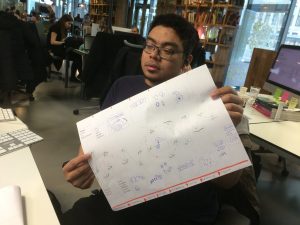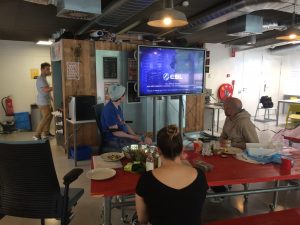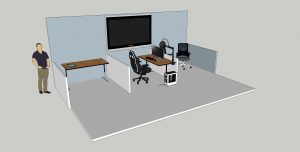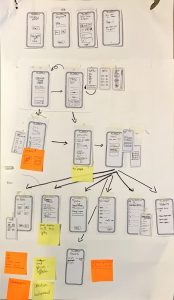
Kicking the sprint off with a hero
Week 1
We have guests! Two experts from the design faculty of Politecnico di Torino in Italy, Fabrizio Valpreda and Paolo Tamborrini. They are going to guide us this week in a mini sprint.
The first day, they introduce us to their design faculty. They tell us about the projects they have worked on and the way they work. It is then time for us to start working with their method of getting to know the problem. We need to do a holistic research on esport events that have passed and explore everything about and around them: the width, location, nearby facilities, visitors etc.
The very first problem we already stumble upon is the fact that we don’t have any hands-on experience; Rizal has attended a few esport events before MediaLAB started, but since the start of our project, nobody has attended one. However, we are currently planning an event to be held at the MediaLAB building. It’s not quite the same, but it’s a nice alternative.

Joao from team Synergy made an inspirational drawing
Fabrizio and Paolo still advise us to do some research on other events such as the recent ESL One event held at Katowice in November. Rizal and Burak each made their own customer journey map based on personal experience.


We have another collective meeting with Fabrizio and Paolo and decide that Rizal’s customer journey map should be elaborated on.

The customer journey map is also part of DDS’ Design Method Toolkit!
In the evening, team Aim pays another visit to Esports Game Arena. They have an esport event of the currently popular shooter game Fortnite going on where everyone could sign up for. Rizal, Burak and Casper (and tag-along Lisa from team H&T) participate in the game. Christine meanwhile sits on the sideline sipping on wine and observing the attendees.

Thank you Rizal for always driving us to far places!

We got 3rd place in the end! Out of 5..
The next morning, we make a presentation based on the following guidelines:
Slide 1: team introduction
Slide 2: analysis of the scenario/project
Slide 3: analysis on the involved tools and users
Slide 4: case studies
Slide 5: ingredients: which kind of users and what parts will we work on?
Slide 6: summary of our ideas and concepts

All the teams gather for one final meeting with Fabrizio and Paolo to show the end results
From this minisprint we looked at our problem from a different perspective and got a nice customer experience map out of it. We also learned some new methods from Fabrizio and Paolo. We are thankful for this opportunity!
Week 2
The whole group gathers around and starts brainstorming for concepts this week. We spend a whole day going back and forth with ideas and decide to work out the best ones.

We meet up with Robbert to talk about the developments around OnLive. We also tell him about our progress and he helps us with brainstorming and shares some thoughts on our newly made concepts.
Tamara joins us for the translate session together with Evelien and Wouter. We present 5 concepts. It is recommended to us that we assess all the strong points from these concepts and see how those can strengthen each other.

Watch out for the Underpants Gnomes
Week 3
We merge a few ideas together and end up with 3 big concepts. We make prototypes for them and present them in the sprint review on Thursday in the Amsterdam ArenA, now officially called the Johan Cruijff ArenA. Zlatina, a teaching method developer joins us for today to see how a sprint review at MediaLAB works so she can take that into account when she helps MediaLAB turn into DSS.

Freek shows us around the ArenA afterwards. Pretty cool!
A summary of the sprint review:
For today’s presentation, team Aim talked about what they did for this sprint. They created visual User Experience maps for the online and offline audience during the before, during and after experience of an esport event based on face-to-face interviews and personal experience. A few results of the questionnaire were used as base for the concepts Aim has elaborated upon. Three final concepts were presented together with their prototypes, which will be described shortly:
-Predicting Game
42% of the answers on the questionnaires indicated that they wouldn’t go to an event because it might be boring. They want to participate in games themselves too during such an event. This concept is similar to ExMachina’s WinView, where you can predict which esports team might win and earn points that way. At the end of the event, you can exchange those points for goods.
-NFC Tags
Poles are placed in the event area that the attendees can interact with with a card they receive upon arriving at the event. It depends heavily on the venue and might be expensive. Freek gave the suggestion of making it a digital kind of NFC Tag that is AR-based.
-Smart Click Map game
Like the game ‘petje op, petje af’, attendees at the event get asked questions like ‘do you prefer dogs or cats?’ and should go to either the left or the right side accordingly. This is livestreamed on Twitch so the online players can also participate with their computer mice. The attendees at the event can then in turn see on a big screen what the online audience thinks.
Aim’s prototype: http://www.team-aim.nl/play/
All of the concepts contain in some way or another the following points:
-Online/offline interaction
-Community forming
-Data Driven
If you are interested in a specific concept, please let team Aim now and they will provide a more elaborate description.
One of the problems Freek noticed about the concepts were that the before and after experience surrounding the event weren’t incorporated as much and didn’t benefit the whole event journey of the customer. Robbert noted that the concepts weren’t esports specific, while that’s an area full of potential. It’s a very specific community that comes together and Aim should look more into the needs of those users and their specific mindset.
So for the next sprint, Aim needs to take those points into account when they work their concepts out. A focus group will be held where the specific mindset of esports-interested gamers will be analysed further. They also should start thinking of what kinds of data they would want to collect in their concepts for the data driven loop. Team Aim is also going to work on improving and prototyping their concepts. They want to arrange a meeting with Wouter from eMense to learn more about event planning, as Aim wants to plan their own event. They also want to meet up with Jeroen or Bastiaan from ExMachina to discuss their WinView and Smart Click Map information and technology.









































